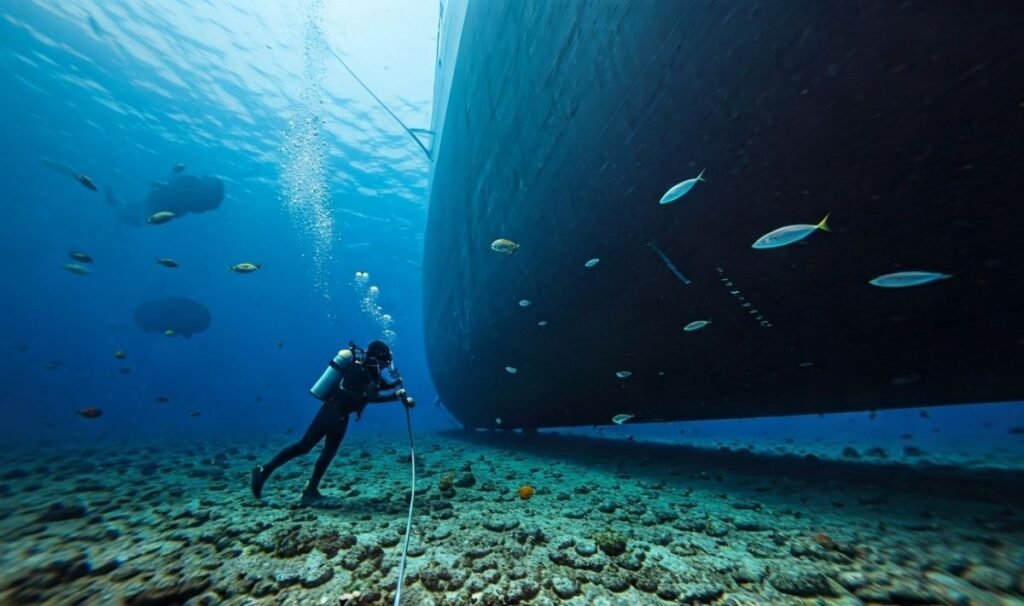What Lurks Beneath the Waterline in Underwater Hull Cleaning in Tuticorin Port?
Have you ever considered the hidden challenges ships face beneath the shimmering waters of Tuticorin Port? What silent threats could be clinging to a vessel’s hull, quietly draining efficiency and increasing costs? In the heart of South India’s maritime trade, underwater hull cleaning is not just routine maintenance—it’s a strategic necessity. But why is it so crucial for ships calling at Tuticorin, and how does it impact the port’s operations, environment, and global competitiveness?
The Unseen Enemy: Marine Fouling and Its Impact on Underwater Hull Cleaning in Tuticorin
Every ship that enters Tuticorin Port is exposed to the relentless grip of marine fouling. Barnacles, algae, and other organisms attach themselves to submerged hulls, creating a rough surface that increases drag. This seemingly harmless buildup can reduce a vessel’s speed by up to 10% and increase fuel consumption by as much as 40%. The consequences? Higher operational costs, more frequent engine maintenance, and a significant rise in carbon emissions. For a bustling port like Tuticorin, where efficiency is paramount, these hidden costs can quickly spiral.
Why is the Importance of Underwater Hull Cleaning in Tuticorin?
Tuticorin Port (officially V.O. Chidambaranar Port) is a vital gateway for international trade, handling millions of tonnes of cargo every year. Its location in the warm, nutrient-rich waters of the Gulf of Mannar makes it especially prone to rapid biofouling. Here’s why regular underwater hull cleaning is a game-changer:

- Enhanced Fuel Efficiency: A clean hull glides through water with minimal resistance, reducing fuel usage and operational expenses.
- Improved Speed and Scheduling: With less drag, ships maintain optimal speed, ensuring timely arrivals and departures, crucial for tight shipping schedules.
- Extended Vessel Lifespan: Removing marine growth prevents corrosion and structural damage, protecting the ship’s value over time.
- Environmental Compliance: Regular cleaning reduces the risk of invasive species transfer and helps meet international environmental standards.
How does Work Underwater Hull Cleaning in Tuticorin Port?
Imagine a large cargo vessel arriving at Tuticorin. Before or during cargo operations, a team of certified divers or robotic cleaners inspects the hull using underwater cameras. They identify areas of heavy fouling and get to work with specialized brushes, high-pressure water jets, and advanced cleaning tools. The process is meticulously planned to avoid disrupting port operations and to ensure all debris is safely collected, preventing pollution.
Sustainability Matters: Protecting Tuticorin’s Marine Ecosystem
Tuticorin Port is surrounded by ecologically sensitive zones, including coral reefs and seagrass beds. Traditional cleaning methods can sometimes release harmful paint flakes or invasive species into the water. That’s why modern hull cleaning in Tuticorin prioritizes:
- Eco-Friendly Techniques: Using non-toxic cleaning agents and advanced containment systems to capture debris.
- No-Discharge Protocols: Ensuring that invasive species and contaminants are not released into the local ecosystem.
- Strict Compliance: Adhering to both Indian and international environmental regulations to protect the Gulf of Mannar’s unique biodiversity.
Choosing the Right Partner: Expertise Makes the Difference
Not all underwater hull cleaning in Tuticorin is created equal. At Tuticorin Port, the best teams combine local knowledge with global best practices. When selecting a service, look for:
- Certified, experienced divers and technicians
- State-of-the-art cleaning equipment
- Transparent inspection reports and documentation
- Proven track record with major shipping lines
Sales Pitch: Experience the Gold Standard in Underwater Hull Cleaning in Tuticorin Port
Are you ready to unlock maximum efficiency for your fleet at Tuticorin? Our expert team offers comprehensive underwater hull cleaning services tailored to the unique conditions of the Gulf of Mannar. We use the latest technology and eco-friendly practices to deliver measurable improvements in speed, fuel efficiency, and regulatory compliance. Don’t let biofouling slow you down—contact us today to schedule a consultation and see the difference for yourself.
Conclusion: Why Underwater Hull Cleaning in Tuticorin Is Non-Negotiable at
So, what lies beneath the surface at Tuticorin Port? The answer is both a challenge and an opportunity. Marine fouling is an invisible enemy that can erode efficiency, inflate costs, and threaten the environment. But with regular, professional underwater hull cleaning, shipowners can safeguard their investments, enhance operational performance, and contribute to a healthier marine ecosystem.
In a port as dynamic as Tuticorin, the benefits are clear: lower fuel bills, faster turnaround times, and compliance with the world’s strictest environmental standards. The next time you see a vessel gliding smoothly out of Tuticorin Port, remember—it’s not just what’s above the waterline that counts. The real secret to maritime excellence lies beneath the surface.
FAQ:
Q1. How often should underwater hull cleaning be performed at Tuticorin Port?
Underwater hull cleaning at Tuticorin Port is typically recommended every 6 to 12 months. The exact frequency depends on the vessel’s type, operational routes, and how long it remains in port waters. Regular cleaning ensures optimal performance, reduced drag, and helps avoid unexpected delays or increased fuel consumption.
Q2. Is underwater hull cleaning in Tuticorin safe for the marine environment?
Yes, when done using eco-friendly tools and proper containment systems, underwater hull cleaning in Tuticorin poses no threat to the marine ecosystem. Responsible service providers use waste collection technologies to prevent debris or marine fouling from polluting the port waters, protecting both biodiversity and regulatory compliance in sensitive marine zones.
Q3. Can hull cleaning be carried out during cargo operations?
Absolutely. Hull cleaning can be scheduled to run simultaneously with cargo loading or unloading. With proper coordination between diving teams and port operations, this minimizes downtime and maximizes efficiency. It allows vessel owners to maintain hull health without affecting the vessel’s commercial schedule or operational deadlines.
Q4. What are the main signs that a vessel needs hull cleaning?
Key signs include increased fuel usage, slower voyage speeds, and visible marine growth like barnacles or algae during underwater inspections. A decline in maneuverability or engine performance might also hint at hull fouling. Regular checks help detect these early and prevent long-term operational inefficiencies.
Q5. Does underwater hull cleaning in Tuticorin help with regulatory compliance?
Yes, regular hull cleaning supports compliance with IMO guidelines and local environmental rules by minimizing invasive species transfer, reducing fuel emissions, and keeping the hull within performance standards. It’s essential for passing Port State inspections and avoiding penalties related to biofouling and marine pollution.


